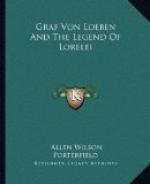[27] An idea as to Loeben’s temperament can
he derived from the
following passage in a letter
to Tieck: “Gott sei mit Ihnen und
die heilige Muse! Oft
drAengt es mich, niederzuknien im Schein, den
Albrecht DUerers und Novalis
Glorie wirft, im alten frommen
Dom. dann denk’ ich
Ihrer und ich lieg’ an Ihrer Seele. Ich
fUehle
Sie in mir, wie man eine Gottheit
fUehlt in geweihter
Stunde. ’Liebe
denkt in sel’gen TOenen, denn Gedanken stehn
zu
fern.” The quotation
should read “sUessen” instead of “sel’gen.”
See Briefe an Tierk.
edited by Holtei, II, 266.
[28] As a corrective to the monographs of Pissin on
Loeben and
H. A. KrUeger on Eichendorff.
one should read Wilhelm Kosch’s
article in Euphorion
(1907, pp. 310-20). Kosch. contends
that Pissin and KrUeger have
vastly overestimated Loeben’s
influence on Eichendorff,
and that Loeben in general was “eine
bedeutungslose Tageserscheinung.”
[29] The complete title is Godwi, oder das steinerne
Bild der
Mutter. Ein verwilderter
Roman von Maria. The very rare first
edition of this novel, in
two volumes, is in the Columbia
Library. Friedrich Wilmans
was the publisher.
[30] Cf. Alfred Kerr, Godwi. Ein Kapitel
deutscher
Romantik. Berlin,
1898, p. 2.
[31] Cf. Wilhelm Hertz, “UEber den Namen
Lorelei,” Sitzungsberichte
der k.b. Akademie der
Wissenschaften zu MUenchen, Jahrgang
1886, pp. 217-51. For
the etymologist, this is an invaluable
study.
[32] The superficial similarity of those two poems
can easily be
exaggerated. The rhyme
“sitzet-blitzet” is perfectly natural:
the
Lorelei had to be portrayed
as “sitzen”; what is then easier than
“blitzen”?
In “Ritter Peter von Stauffenberg und die Meerfeye”
(Des Knaben Wunderhorn, ed.
of Eduard Grisebach, p. 277) we have
this couplet:
Er sieht
ein schOenes Weib da sitzen.
Von Gold
und Silber herrlich blitzen.
For more detailed illustrations, see below.
[33] It is worth while to note the actual date of
Heine’s composition
of his ballad, since so eminent
an authority as Wilhelm Scherer
(Ges. d. deut. Lit.,
8th ed., p. 662) says that Heine wrote the
poem in 1824. And Eduard
Thorn (Heinrich Heines Beziehungen zu
Clemens Brentano, p. 90.)
says that he published it in 1826.
This is incorrect, as is also
Thorn’s statement, p. 88, that
Brentano wrote his ballad
in 1802. For the correct date of Heine’s
ballad, see SAemtliche
Werke, Hamburg, 1865, XV, 200.]




